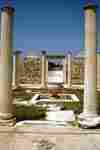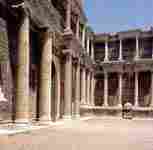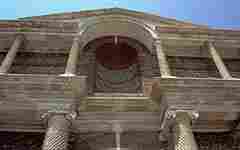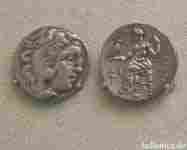.
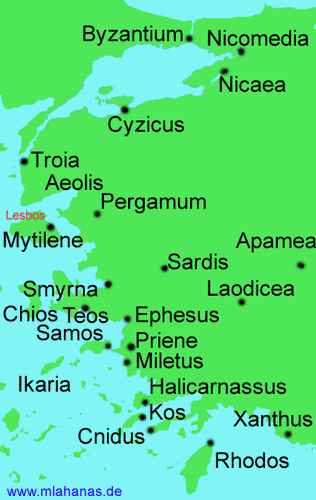
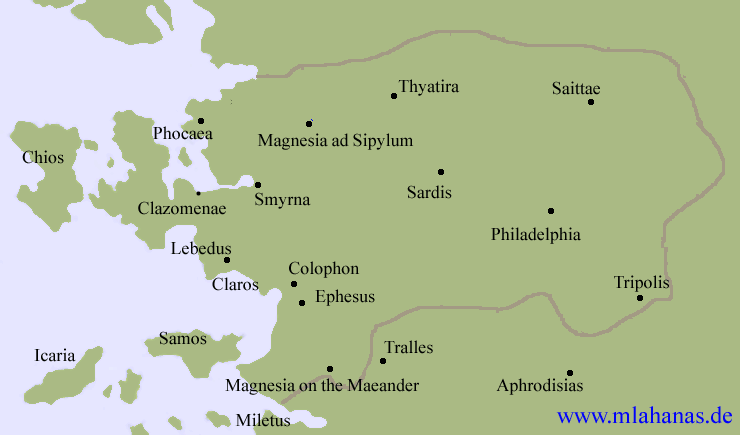
Sardis or Sardes (Lydian: Sfard; Greek: Σάρδεις, Sardeis; Persian: سارد, Sārd) was an ancient city at the location of modern Sart (Sartmahmut before 19 October 2005) in Turkey's Manisa Province. Sardis was the capital of the ancient kingdom of Lydia,[1] one of the important cities of the Persian Empire, the seat of a proconsul under the Roman Empire, and the metropolis of the province Lydia in later Roman and Byzantine times. As one of the Seven churches of Asia, it was addressed by the author of the Book of Revelation in terms which seem to imply that its population was notoriously soft and fainthearted. Its importance was due, first to its military strength, secondly to its situation on an important highway leading from the interior to the Aegean coast, and thirdly to its commanding the wide and fertile plain of the Hermus.

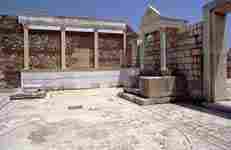
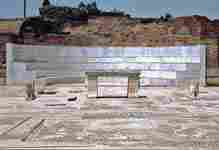
Geography
Map of Sardis and Other Cities within the Lydian Empire
Sardis was situated in the middle of Hermus valley, at the foot of Mount Tmolus, a steep and lofty spur which formed the citadel. It was about 4 kilometres (2.5 mi) south of the Hermus. Today, the site is located by the present day village of Sart, near Salihli in the Manisa province of Turkey, close to the Ankara - İzmir highway (approximately 72 kilometres (45 mi) from İzmir). The part of remains including the bath-gymnasium complex, synagogue and Byzantine shops is open to visitors year-round.
History
See also: Lydia (Achaemenid)
Remains of the Byzantine shops in Sardis
The earliest reference to Sardis is in the The Persians of Aeschylus (472 BC); in the Iliad the name Hyde seems to be given to the city of the Maeonian (i.e. Lydian) chiefs, and in later times Hyde was said to be the older name of Sardis, or the name of its citadel. It is, however, more probable that Sardis was not the original capital of the Maeonians, but that it became so amid the changes which produced the powerful Lydian empire of the 8th century BC.
The city was captured by the Cimmerians in the 7th century BC, by the Persians in the 6th, by the Athenians in the 5th, and by Antiochus III the Great at the end of the 3rd century BC. In the Persian era Sardis was conquered by Cyrus the Great and formed the end station for the Persian Royal Road which began in Persepolis, capital of Persia. During the Ionian Revolt, the Athenians burnt down the city. Sardis remained under Persian domination until it surrendered to Alexander the Great in 334 BC.
The early Lydian kingdom was far advanced in the industrial arts and Sardis was the chief seat of its manufactures. The most important of these trades was the manufacture and dyeing of delicate woolen stuffs and carpets. The stream Pactolus which flowed through the market-place "carried golden sands" in early antiquity, which was in reality gold dust out of Mt. Tmolus. It was during the short (14-year) reign of King Croesus from 595 BC to 547?BC that the metallurgists of Sardis discovered the secret of separating gold from silver, thereby producing both metals of a purity never known before.[2] This was an economic revolution, for while gold nuggets panned or mined were used as currency, their purity was always suspect and a hindrance to trade. Such nuggets or coinage were naturally occurring alloys of gold and silver known as electrum and one could never know how much of it was gold and how much was silver. Sardis now could mint nearly pure silver and gold coins, the value of which could be—and was—trusted throughout the known world. This revolution made Sardis rich and Croesus' name synonymous with wealth itself. For this reason, Sardis is famed in history as the place where modern currency was invented.
Disaster came to the great city under the reign of the emperor Tiberius, when in AD 17, Sardis was destroyed by an earthquake;[3] but it was always rebuilt. It was one of the great cities of western Asia Minor until the later Byzantine period.
Later, trade and the organization of commerce continued to be sources of great wealth. After Constantinople became the capital of the East, a new road system grew up connecting the provinces with the capital. Sardis then lay rather apart from the great lines of communication and lost some of its importance. It still, however, retained its titular supremacy and continued to be the seat of the metropolitan bishop of the province of Lydia, formed in AD 295. It is enumerated as third, after Ephesus and Smyrna, in the list of cities of the Thracesion thema given by Constantine Porphyrogenitus in the 10th century; but over the next four centuries it is in the shadow of the provinces of Magnesia-upon-Sipylum and Philadelphia, which retained their importance in the region.
After 1071 the Hermus valley began to suffer from the inroads of the Seljuk Turks but the Byzantine general John Doukas reconquered the city in 1197, the successes of the general Philokales in 1118 relieved the district from later Turkish pressure and the ability of the Comneni dynasty together with the gradual decay of the Seljuk Sultanate of Rum meant that it remained under Byzantine dominion. When Constantinople was taken by the Venetians and Franks in 1204 Sardis came under the rule of the Byzantine Empire of Nicea. However once the Byzantines retook Constantinople in 1261, Sardis with the entire Asia Minor was neglected and the region eventually fell under the control of Ghazi (Ghazw) emirs, the Cayster valleys and a fort on the citadel of Sardis was handed over to them by treaty in 1306. The city continued its decline until its capture (and probable destruction) by the Mongol warlord Timur in 1402.
Archaeological expeditions
By the 19th century, Sardis was in ruins, showing construction chiefly of the Roman period. The first large scale archaeological expedition in Sardis was directed by a Princeton University team led by Howard Crosby Butler between years 1910 - 1914, unearthing a temple to Artemis, and more than a thousand Lydian tombs. The excavation campaign was halted by World War I, followed by the Turkish War of Independence, though it briefly resumed in 1922. Some surviving artifacts from the Butler excavation were added to the collection of the Metropolitan Museum of Art in New York.
Since 2008, the excavation has been under the directorship of Nicholas Cahill, professor at the University of Wisconsin–Madison.[4] The laws governing archaeological expeditions in Turkey ensure that all archaeological artifacts remain in Turkey. Some of the important finds from the site of Sardis are housed in the Archaeological Museum of Manisa, including Late Roman mosaics and sculpture, a helmet from the mid-6th century BC, and pottery from various periods.
Sardis synagogue
Main article: Sardis Synagogue
A recent view of the Sardis Synagogue
Since 1958, both Harvard and Cornell Universities have sponsored annual archeological expeditions to Sardis. These excavations unearthed perhaps the most impressive synagogue in the western diaspora yet discovered from antiquity, yielding over eighty Greek and seven Hebrew inscriptions as well as numerous mosaic floors. (For evidence in the east, see Dura Europos in Syria.) The discovery of the Sardis synagogue has reversed previous assumptions about Judaism in the later Roman empire. Along with the discovery of the godfearers/theosebeis inscription from the Aphrodisias, it provides indisputable evidence for the continued presence of Jewish communities in Asia Minor and their integration into general Roman life at a time when many scholars previously assumed that Christianity had eclipsed Judaism.[CN]
The synagogue was a section of a large bath-gymnasium complex, that was in use for about 450 – 500 years. In the beginning, middle of the 2nd century AD, the rooms the synagogue is situated in were used as changing rooms or resting rooms. The complex was destroyed in 616 AD by the Sassanian-Persians.[CN]
Sardis and the Hebrew Sepharad may have been one and the same.
See also
Lydia
Cities of the ancient Near East
Manisa
Byzantine
List of synagogues in Turkey
References
^ Rhodes, P.J. A History of the Classical Greek World 478-323 BC. 2nd edition. Chichester: Wiley-Blackwell, 2010, p. 6.
^ A. Ramage, P. Craddock, King Croesus' Gold: Excavations at Sardis and the History of Gold Refining. Archaeological Exploration of Sardis, Arch. Expl. Sardis (2001)
^ Tacitus, The Annals 2.47
^ "Archaeological Exploration of Sardis, Harvard Art Museums". Retrieved January 9, 2013.
Further reading
Hanfmann, George M.A., Et al. Sardis from Prehistoric to Roman Times: Results of the Archaeological Exploration of Sardis 1958-1975, Harvard University Press. ISBN 0-674-78925-3
External links
The Archaeological Exploration of Sardis, of the Harvard University Art Museums
The Search for Sardis, history of the archaeological excavations in Sardis, in the Harvard Magazine
Sardis, at the Metropolitan Museum of Art, New York
Sardis Turkey, a comprehensive photographic tour of the site
The Princeton Encyclopedia of Classical Sites - Sardis
Livius.org: Sardes - pictures
Greece :
A - B - C - D - E - F - G - H - I - J - K - L - M -
N - O - P - Q - R - S - T - U - V - W - X - Y - Z
| Ancient Greece
Science, Technology , Medicine , Warfare, , Biographies , Life , Cities/Places/Maps , Arts , Literature , Philosophy ,Olympics, Mythology , History , Images Medieval Greece / Byzantine Empire Science, Technology, Arts, , Warfare , Literature, Biographies, Icons, History Modern Greece Cities, Islands, Regions, Fauna/Flora ,Biographies , History , Warfare, Science/Technology, Literature, Music , Arts , Film/Actors , Sport , Fashion --- |
Retrieved from "http://en.wikipedia.org/"
All text is available under the terms of the GNU Free Documentation License




